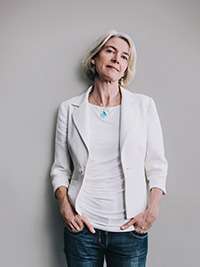Jennifer Doudna Honored with For Women in Science Award
 Jennifer Doudna, Ph.D., one of the brains behind the revolutionary CRISPR-Cas9 gene editing technology, started out as a self-proclaimed “nerdy, geeky type” who loved math and tried to figure out how the world works by performing experiments.
Jennifer Doudna, Ph.D., one of the brains behind the revolutionary CRISPR-Cas9 gene editing technology, started out as a self-proclaimed “nerdy, geeky type” who loved math and tried to figure out how the world works by performing experiments.
Doudna, along with five other outstanding Laureates, will be honored on March 24 for her groundbreaking work, with the L’Oreal-UNESCO For Women in Science Award in Paris. Doudna, professor in the department of molecular and cell biology at the University of California, Berkeley and an investigator at the Howard Hughes Medical Institute, told Bioscience Technology about her early exploration into science and where she thinks CRISPR will have the biggest impact.
Before becoming a renowned scientist, Dounda was a curious kid interested in discovery. Her first introduction to biochemistry came in middle school, when her father gave her James Watson’s The Double Helix. “When I picked it up, I couldn’t put it down,” she told Bioscience Technology. “A high school chemistry class cemented my determination to become a scientist.”
During her time at Hilo High in Hawaii her interest was stoked further by a presentation from a woman from the University of Hawaii who detailed processes that took place at the molecular level and how normal cells became cancerous.
“I was just dumbstruck and so fascinated by her work,” Doudna said. “I said to myself ‘that’s exactly what I want to do, I want to be her.’”
Doudna said she got some lab time under her belt, working at a family friend’s lab over the summer collecting samples and embedding them in resins, then examining thin slices under an electron microscope. “I was captivated by it – looked forward to going in every day,” she said. “I was always thinking, ‘I’m going to uncover a mystery today!’” Doudan said she credits her various experiences in Hilo with the choices that eventually led to her career.
That love of discovery is something she wants to point out to postdoctoral or younger scientists – that science is about asking questions. She cautions, though, that one then has to be patient while figuring out the answers to questions, and to “pay attention to little details that might be unexpected in one’s research.”
Doudna, a highly accomplished scientist herself sees opportunities improving for women in STEM. “The more women we invite into the field of science and support, the more this will change. L’Oreal-UNESCO’s For Women in Science program is doing amazing work in terms of encouraging women to pursue STEM— it’s about creating an environment that celebrates and supports the important work women in science are doing.”
CRISPR’s far-reaching implications
CRISPR, which acts like molecular scissors, is a relatively simple way to modify an organism’s DNA. It has tremendous potential, from treating and curing diseases, to agricultural uses for tweaking food.
The potential uses of CRISPR are great, but in the medium term Doudna said she thinks that we’re going to see CRISPR-Cas9 technology used to repair mutations that are well-known to cause genetic diseases, like sickle-cell anemia and other blood disorders.
“We have a pretty good idea about how we could actually introduce the Cas9 protein and its guiding RNA into those cells to create the changes that are necessary for therapeutic benefit,” she said.
In the longer term, Doudna hopes to see the technology applied to other types of genetic diseases such as diseases of the liver, the lung, and cystic fibrosis.
“Duchenne muscular dystrophy is caused by a genetic mutation, in which the mutations have been known for a while, but we have not had, until now, an effective tool to employ for correcting them.”
While CRISPR has many exciting potential applications, the new technology also comes with many ethical concerns, such as germline editing, where traits are passed down to the next generation. Some worry that this could lead to designer babies whose genome has been edited not for disease prevention but for things like intelligence or physical traits — and Doudna has led the charge in asking scientists to consider and weigh ethical considerations. In December a group of international scientists convened at a meeting where they called for a moratorium on making inheritable changes to the human genome.
“Science is global, and countries across the world have different perspectives on how to use CRISPR,” Doudna said. “This is why we’ve called for a moratorium on its use, as I had a growing sense that there were profound ethical concerns where genetic changes in embryos are put into future generations.”
Doudna said she also believes that scientists should be better prepared to think about and shape the societal, ethical and ecological consequences of their work. “Providing biology students with some training about how to discuss science with non-scientists could be transformative.”
The fame that came with the development of CRISPR has been a surprise to Doudna, but she said she’s very grateful for the attention it brings to gene editing.
“Being honored by programs such as L’Oreal-UNESCO’s For Women in Science is not just about receiving a grant or title, but it’s a privilege to be amongst a very strong group of incredibly smart and accomplished female scientists.”
Another U.S.-based scientist, postdoctoral astrophysics researcher Sabrina Steirwalt, Ph.D., from the University of Virginia, will also be honored at the event as an International Rising Talent for her work on the study of how galaxies evolve.
After being nominated by others in the field, the five 2016 Laureates were selected by an independent and international jury of scientists, and each will receive 100,000 euros.





